
A light snow is falling as I make toward the twinkling lights ahead. My friends and I are headed to the Christmas market in Fulda, Germany, and there’s a sense of anticipation in the air.
Christmas, a time of enchantment and traditions, transforms the entire country into a festive wonderland.
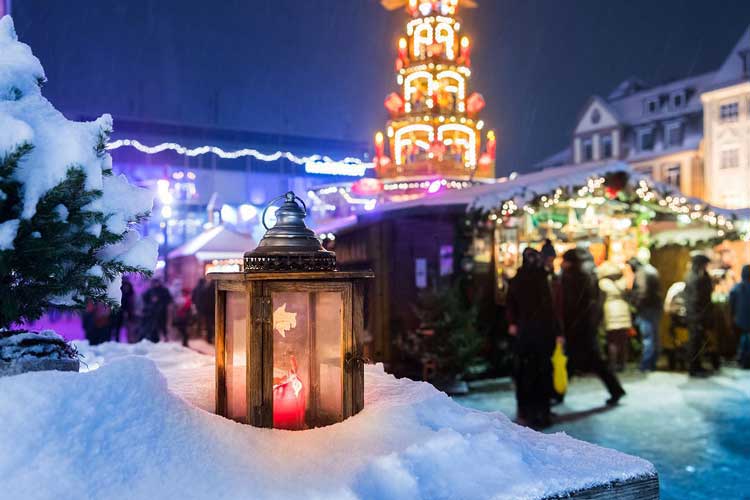
Christmas is one of my favorite times to visit Germany. I’ve visited during the holidays several times over the years, and each time, I leave wanting to return.
One December, my husband, Benjamin, and I rented a car and visited small-town Christmas markets along the Danube. Another time, we visited the sprawling Christmas markets in Ulm and Regensburg.
My journey this year has led me to the German state of Hesse in central Germany, where the Christmas markets are not just events but a huge part of the community.

Why is Christmas Such a Special Time to Visit Germany?
Germany’s celebration of Christmas is more than just a holiday; it’s a cultural phenomenon. The entire country is adorned with twinkling lights, festive decorations, and a spirit of togetherness.
Christmas markets, or “Weihnachtsmärkte,” are at the heart of this celebration, offering a glimpse into Germany’s rich traditions.
German Christmas traditions blend treasured customs with modern twists. The air is filled with the aroma of spiced wine and the melodies of carolers, creating an atmosphere that’s nothing short of magical. Each town or city has its unique version of the Christmas market. We plan to stop at several of them.
Seligenstadt: Old Town, Kloster Seligenstadt and the Christmas Market
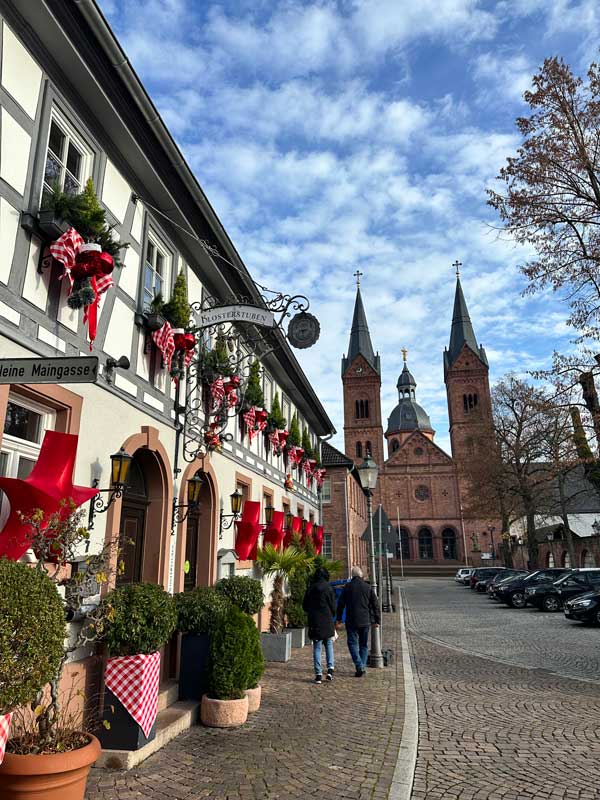
After flying into Frankfurt, the largest city in Hesse, we had started our journey in the small medieval town of Seligenstadt, about a 45-minute drive from Frankfurt.
We strolled through its Old Town, filled with quiet cobbled streets and half-timbered houses, and stopped at the Kloster Seligenstadt, a Benedictine abbey with a rich history. Today, it makes some of the best bread I’ve ever tasted.
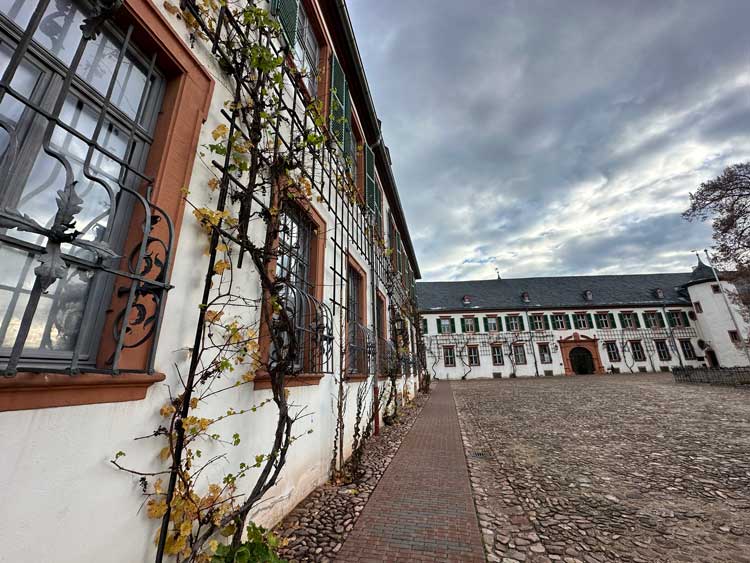
The Seligenstadt Christmas market was just getting set up, so we continued to the town of Fulda.
Fulda, Germany: Exploring Old Town
Fulda is known as the most beautiful baroque town in Hesse. With around 70,000 inhabitants, it’s big enough to have a vibrant city life, but still small enough to have the feel of a small community.
During the day, we toured its well-preserved Old Town, adorned with stunning baroque architecture. A highlight was a tour of the Fulda Cathedral, which was built in the 18th century by famous master builder Johann Dientzenhofer. Though originally a Catholic Church, that changed after the Reformation. Today it’s an Episcopal church. It was damaged in WWII but still stands tall today.
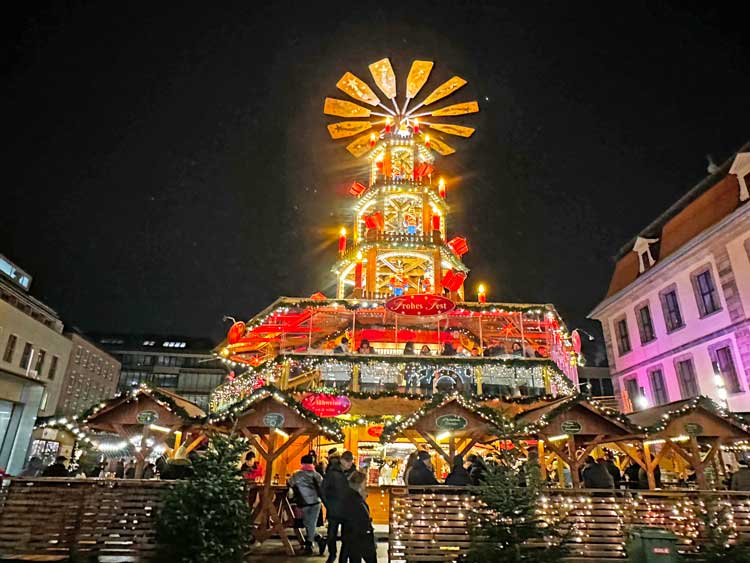
Fulda Christmas Market
Now, as evening falls, we make our way to the traditional Christmas market in Fulda’s historic square. Light snow glistens in the twinkling lights that adorn each market stall. Many local vendors offer handcrafted ornaments and regional specialties.
The Fulda Christmas market has a program to support smaller local vendors who can only afford to rent stalls for a week or two. This provides visitors with products that you normally wouldn’t see in a Christmas market.
The Fulda Christmas market has several distinct sections, including a gourmet market, a medieval village, a Christmas Land for children and even a festive winter forest.
My favorite part of Christmas markets is always the food and drink. Glühwein is the most popular drink, but I also like the hot apple wine and steaming cups of hot chocolate.
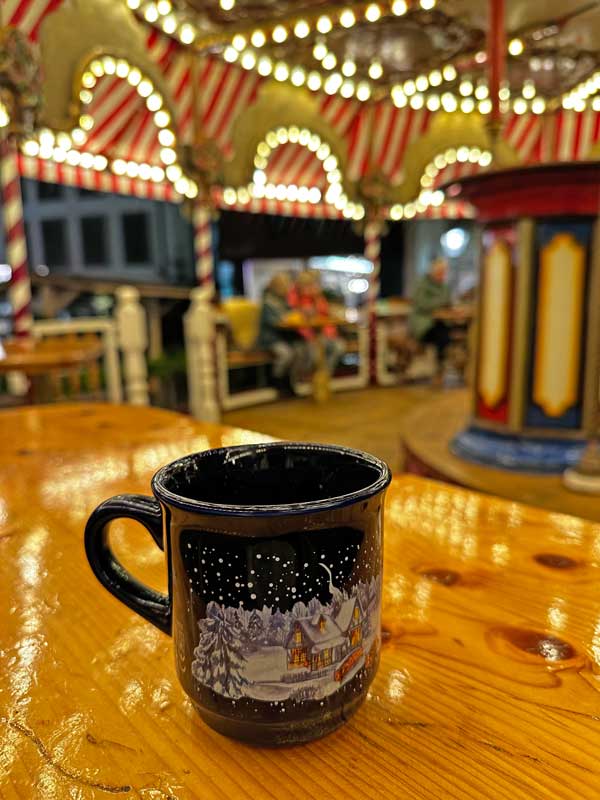
What is Glühwein?
Gluhwein, also known as mulled wine, is a traditional winter beverage that has its roots in European holiday traditions. The name “gluhwein” is derived from the German words “glühen,” meaning to glow, and “wein,” meaning wine.
Typically made with red wine, various spices such as cinnamon, cloves, and star anise are added to the mixture, along with orange peel and sometimes sugar. The concoction is then heated, allowing the spices to infuse into the wine and creating a warm, flavorful drink that is especially popular during the colder months, especially at Christmas markets.
Every Christmas market creates a special Glühwein mug for the season. I’ve gathered quite a nice collection of them over the years.
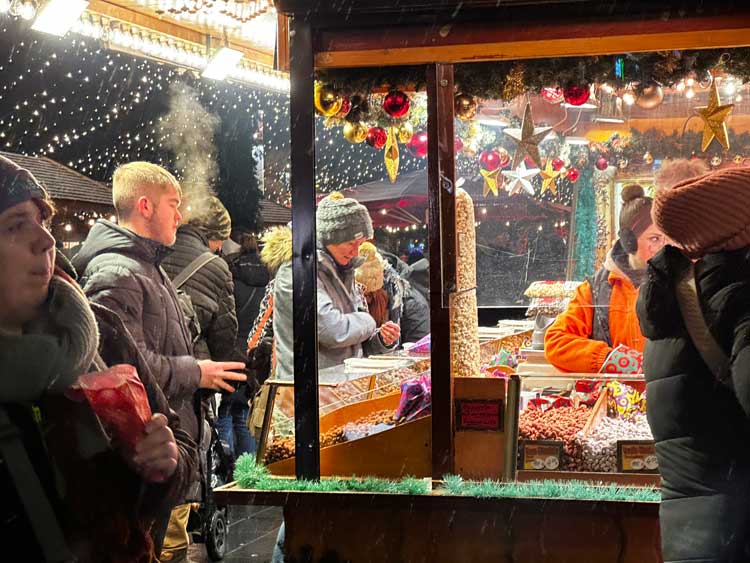
In one corner of the Fulda Christmas Market, a Merry-Go-Round has been turned into seating, so we linger there to enjoy our food. Cupping the warm mug in my hands, I drink my Glühwein and try several dishes from nearby food stands.
We even sample an excellent vegan hot dog, which is made with a carrot, greens, a bun, and savory sauces. Traditional dishes include pretzels, candied nuts, sausages and more.
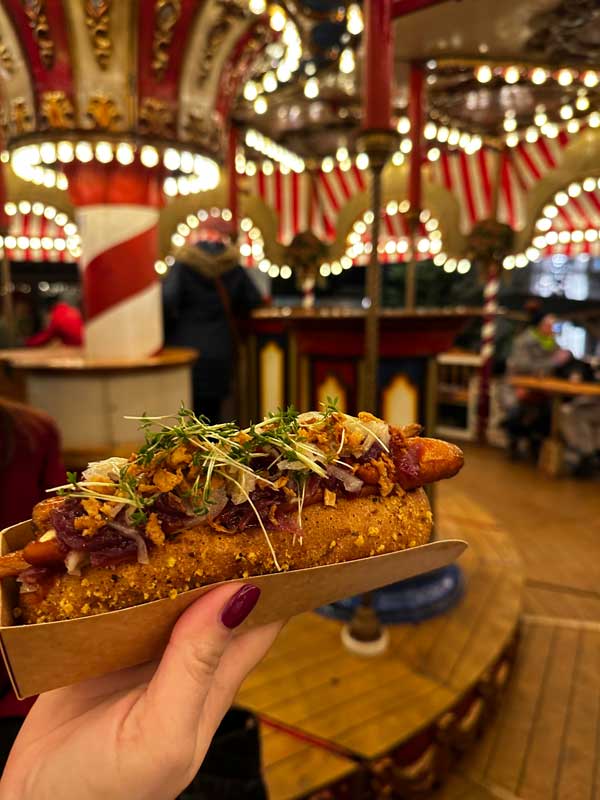
Marburg, Germany: Old Town, Grimm-Dich Path, and Lunch at Buckingsgarten
Our next stop, Marburg, with its medieval Old Town and half-timbered houses, promises a day of picturesque exploration. The town was once home to the famous Brothers Grimm, who recorded and shared fairy tales that would charm children for generations.
On a tour of Marburg, we follow a section of the Grimm-Dich Path, a trail dedicated to the Brothers Grimm. We pass whimsical sculptures of their stories, including the huge red shoe of Cinderella. Lunch at Buckingsgarten, a lovely restaurant nestled in a captivating garden, fuels our journey through Marburg’s festive streets.
Marburg’s Traditional Dagobertshäuser Christmas Market
The Traditional Dagobertshäuser Christmas Market in Marburg is small but charming. Held in a tidy square, it has a romantic atmosphere as well as warm buildings where visitors can eat. I like the warm apple cider donuts and fried churros with several choices of toppings.
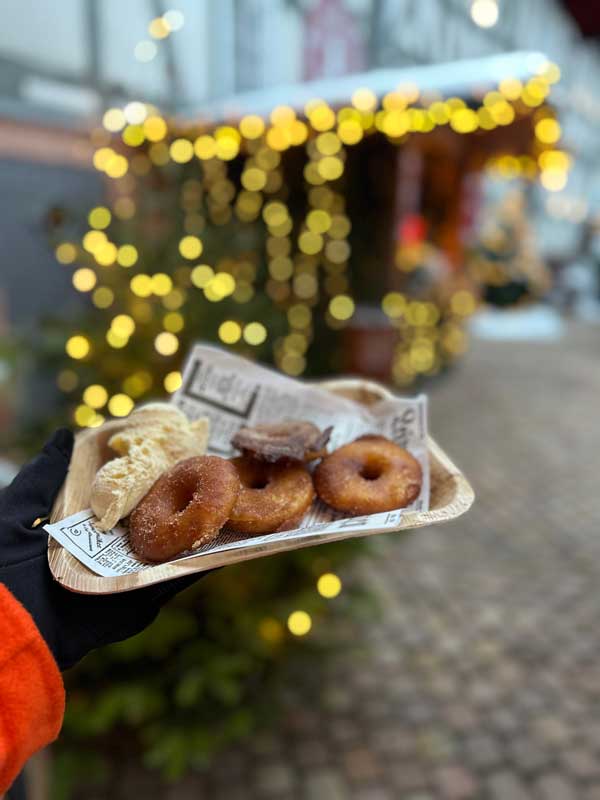
Christmas in Kassel, Germany
The final leg of our Hessian Christmas adventure takes me to Kassel, where history and whimsy converge.
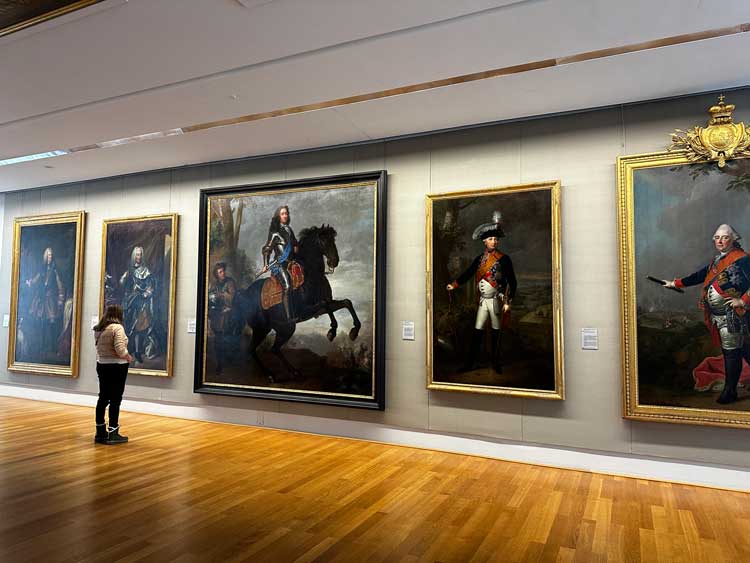
A highlight of Kassel is no double the massive Wilhelmshöhe Palace, a UNESCO World Heritage site. Established in 1786 for Count Wilhelm IX, it is now an important museum that is home to the Old Masters Picture Gallery. The exhibits showcase more than 500 years of regional history.
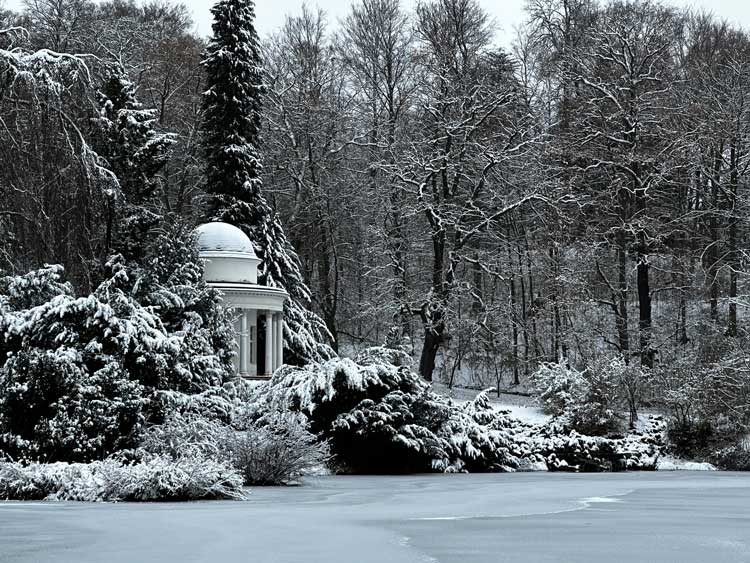
The palace has more than 590 acres of gardens which are a magical winter wonderland. After exploring the museum, we head into the gardens, following snow-covered paths through the trees. It was nothing short of magical.
GRIMM Welt: A Museum Dedicated to the Brothers Grimm
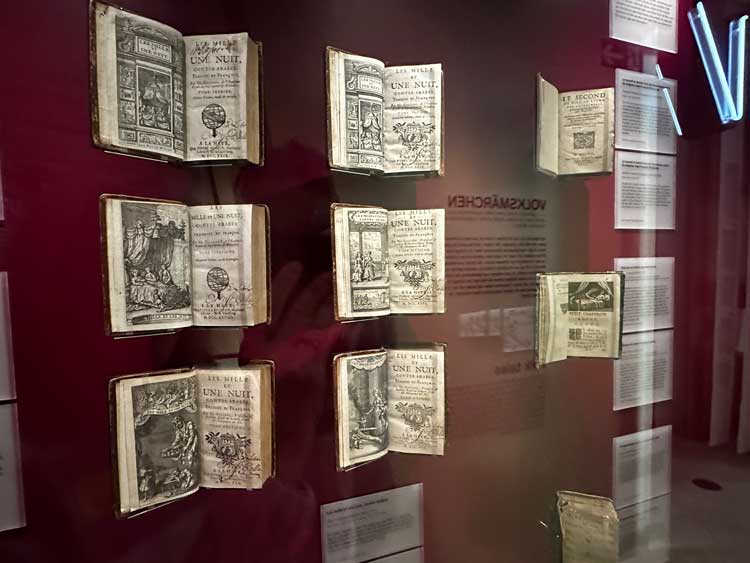
Another popular attraction in Kassel is GRIMM Welt, a museum dedicated to preserving the legacy of the Brothers Grimm and their timeless fairy tales.
The Brothers Grimm, Jakob Ludwig Karl Grimm (born on January 4, 1785) and Wilhelm Carl Grimm (born on February 24, 1786), were German scholars, linguists, philologists, and folklorists. They are best known for compiling and popularizing traditional European folktales. The most famous collection of their fairy tales is “Grimm’s Fairy Tales” (“Grimm’s Märchen” in German), first published in 1812.
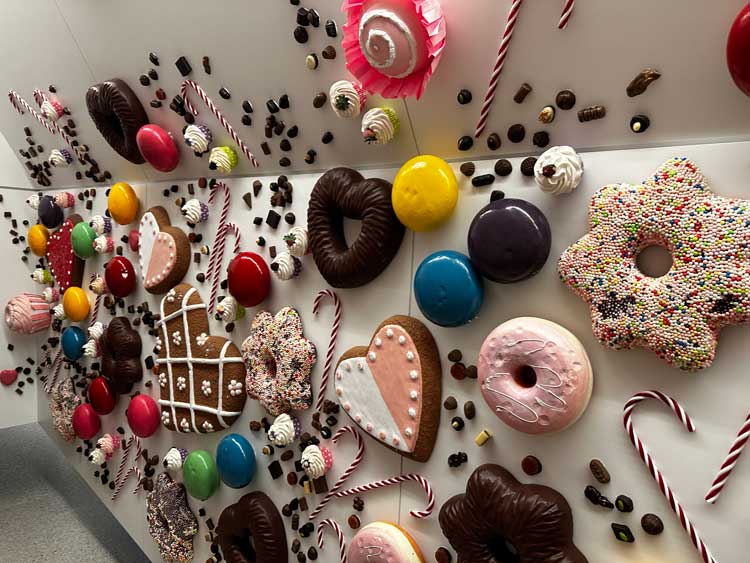
The Grimms’ fairy tales include well-known stories such as “Cinderella,” “Snow White,” “Hansel and Gretel,” “Little Red Riding Hood,” and many others. Over time, their collection has been translated into numerous languages and has become a significant part of world literature. The tales have been adapted into various forms of media, including theater, film, and animation, and they continue to captivate audiences worldwide
The journey through GRIMM Welt is a mesmerizing exploration of the lives and creations of Jacob and Wilhelm Grimm. The exhibition unfolds their life stories alongside the origins of their fairy tales. Innovative multimedia displays, interactive exhibits, and a rich collection of artifacts transport visitors back to the 19th-century world that inspired these iconic storytellers.
Enchanted at the Kassel Fairy Tale Christmas Market
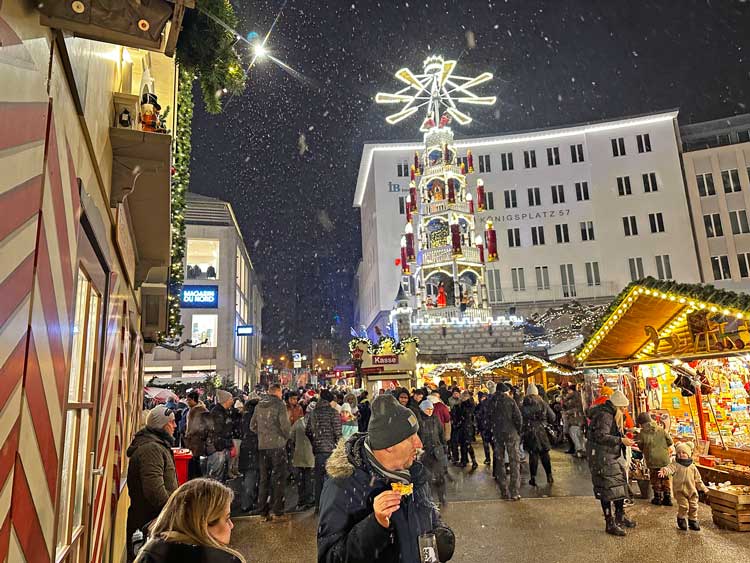
Fairy Tales are the theme of Kassel’s famed Christmas Market. Aptly called the Kassel Fairy Tale Christmas Market, it highlights one fairy tale each season. This year, the famous character is Snow White.
The Christmas market is buzzing with activity as local families and friends enjoy the festive atmosphere. The market kicks off with the appearance of Santa Claus himself, who flies over the market in a blaze of twinkling lights.
The market’s stalls are a treasure trove of handcrafted goods, unique gifts, and festive treats. From intricately crafted ornaments to steaming mugs of spiced mulled wine, each vendor adds to the market’s charm.
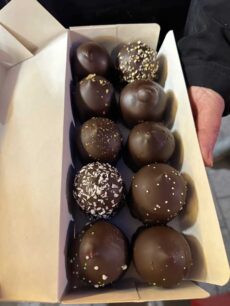
I can’t resist indulging in local delicacies, starting with Schaumküssen (foam kisses), sweet marshmallow-like concoctions covered in chocolate, available in many different flavors.
The Kassel Fairy Tale Christmas Market is not just a place to shop; it is a chance to step into the local community. Children delight in all the kid-friendly activities, including an appearance by Snow White herself.
In the heart of Hesse, Germany, Christmas is more than a season; it’s a journey through German culture and tradition. Perhaps that’s what makes it such a special place to celebrate the season.
Read More: Travel in Germany
